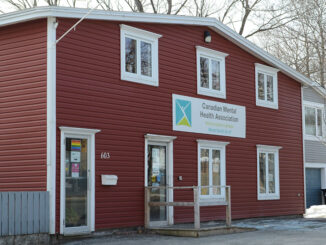Nature park staff expect to see resident woodchuck in April at the earliest.

Lynx, falcons, snowshoe hares: These are just some of the rare species one is likely to spot while strolling past the animal enclosures at Salmonier Nature Park.
But enclosure number seven houses the rarest species of them all: the Marmota monax, otherwise known as the groundhog.
Like deer, snakes, skunks and porcupines, groundhogs (or woodchucks) are not native to Newfoundland, and, according to the department of Fisheries, Forestry and Agriculture’s website, only one exists on the island. Salmonier Nature Park in St. Mary’s Bay is the only place visitors can observe a real life groundhog without leaving the island, and wildlife experts say it will likely stay that way.
“Generally, introducing rodents on the island causes catastrophic damage,” said Ian Jones, a biology professor at Memorial University, “so thankfully, nobody has tried to introduce [groundhogs] here.”
Dig this
Michael Blackwood has been working as an interpretation technician at Salmonier Nature Park since 2005, not long after the site welcomed its first-ever woodchuck.
Since then, a number have come and gone from the site (groundhogs live up to six years). The current rodent-in-residence is a four-year-old male. He was neutered, Blackwood said, “to prevent the possibility of accidental introduction.”

In keeping with the site’s policy against naming animals—Blackwood said it helps visitors see them as wild creatures, and not as pets—the woodchuck at enclosure seven is known only as such. His life philosophy, Blackwood said, is a simple one: “Eat as much as possible, and do as little as possible.”
“They’re quite happy to just eat and relax,” he said. “So it’s a pretty easy lifestyle to identify with.”
The Salmonier groundhog’s summers are spent basking in the sun, Blackwood said, usually after feasting on carrots, cabbage, leafy greens and other staples of the Newfoundland diet.
Blackwood said the only real challenge in keeping Newfoundland’s sole groundhog in captivity, is keeping him in captivity.
As the largest member of the squirrel (Sciuridae) family, woodchucks are “extremely adept” at digging, Blackwood said. “So they’re quite capable of digging out of an enclosure if it is not designed specifically for them.”
For that reason, Blackwood said building an enclosure for Newfoundland’s only groundhog required “a lot of forethought,” not to mention extensive excavation, and more than a little escape-proofing.

Enclosure number seven features a chain-link fence, chain-link floor, and enough earth piled on top to allow the woodchuck to burrow a hole beneath the frost line.
The vertical fencing also had to be equipped with an overhang. (Woodchucks are “very good at climbing,” Blackwood said—but not so great at hanging upside down.)
“So that’s the challenge of keeping them in their enclosure,” he said.
Risky rodents
Given the chance, Blackwood said, it’s possible groundhogs could colonize the island of Newfoundland.
“They’re a really widespread species—they’re found from southern Labrador down the Eastern seaboard to the U.S.,” said Blackwood. “So the climate is not an issue here.”
And while its likely woodchucks would find some well-drained grasslands to inhabit on the island, Blackwood said the risk of introducing a new species would be too high.
“You never know what’s going to happen when a species reaches a new territory,” he said.
As for the likelihood of the Salmonier woodchuck emerging from his hole in time for Groundhog Day on Feb. 2, Blackwood said it’s unlikely: He feasted enough in summer to get him through well into spring, Blackwood said.
“The earliest we’ve ever had one emerge was April,” Blackwood said. “If we have an early spring, he will emerge before that.”





Be the first to comment